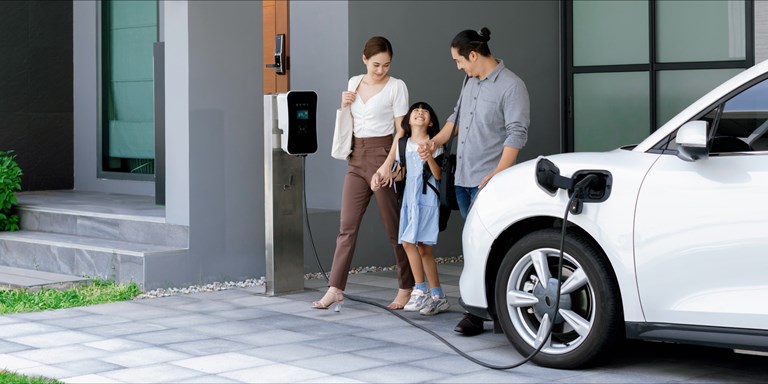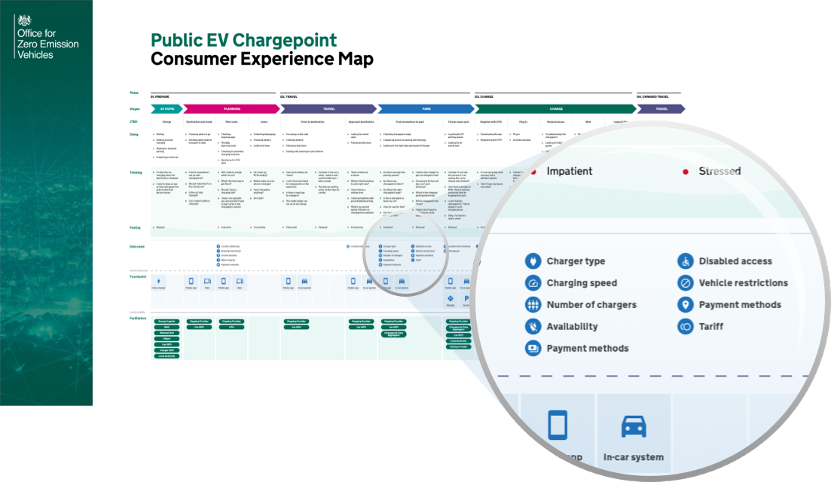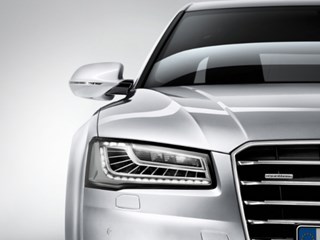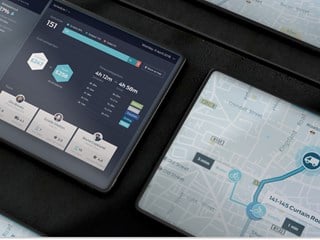OZEV
Introducing the OZEV open electric vehicle chargepoint data discovery project

Facts
Industry
- Público
- Mobilidade
Service
- Evolução de Dados
Get to know the office for zero-emission vehicles
Transport produces one out of every four tonnes of CO2 in the UK. Of that, nearly two-thirds is emitted by cars and taxis alone1. In response, the Office for Zero Emission Vehicles (OZEV) is working across government to support the UK’s transition to electric vehicles (EVs).
OZEV aims to increase economic growth while reducing greenhouse gas emissions and air pollution. It supports the uptake of plug-in vehicles and funds chargepoint infrastructure across the UK. Its work is high profile and high priority: the government has committed to banning the sale of new petrol and diesel cars by 2030 and, as of December 2021, had allocated £3.5 billion to support the transition to EVs2.

What OZEV needed
OZEV
OZEV’s focus is to get more people to use zero-emission vehicles. But how do we achieve that? Having consulted across stakeholder groups, one consistent theme was that the availability of data is critical to improving the user experience of chargepoints and that this will lead to more people adopting EVs.
Specifically, EV drivers have “range anxiety” about where and when they can next charge their vehicle. To be confident about making the switch, they need reliable and consistent information about where they can find a useable chargepoint.
User anxiety is higher when individuals have mobility issues. These can include problems with the weight of charging cables or parking arrangements unsuitable for wheelchair users. Recent research estimates there will be 2.7 million disabled drivers or passengers by 2035, with 1.35 million expected to be partially or wholly reliant on public charging infrastructure3.
Meanwhile, local authorities and the energy suppliers who provide chargepoints need data to help ensure that new chargepoints are located where it’s feasible to put them and where they’re needed. The richness of data isn’t currently available that can enable sensible chargepoint planning for users or operators, plus there are business opportunities to fill these gaps.
OZEV decided to conduct a Discovery on open data and where it can contribute to their goals to learn more4. Specifically, OZEV wanted the Discovery to:
-
Fully understand consumer and industry needs
-
Identify whether existing approaches in the transport, energy and other utility sectors could meet those needs
-
Confirm the feasibility and application of data standards to support the outcomes
-
Suggest viable, future-proofed, practical solutions for how data can be made available and used to meet all the needs of consumers
How we Approach the Discovery
When Valtech bid for this work, we put together a unique package. As well as building on our proven track record of conducting successful Discoveries and our established reputation for creating good government services, we also partnered with TRL to ensure we had appropriate, detailed domain knowledge.
TRL was originally the UK Government’s road research body and is now an independent team of expert scientists and engineers working with clients on the future of transport. They’d recently conducted European-wide consumer research on EVs. Our proposition to OZEV was that our team had the skills to complete an effective data discovery project, and the domain knowledge to hit the ground running and make the best use of the time available.
Discoveries are highly focused and time limited. To organise our time effectively, we divided our plan into four stages. The first was identifying all the existing knowledge in the current landscape, filling in the gaps with our own research. The second was processing all the raw information we’d gathered to extract insights and create propositions.
In the third stage, we recombined the propositions and generated ideas about how each could be tackled or solved. We also grouped, consolidated and refined the propositions to identify the most achievable and the ones that would have the biggest impact on the customer experience or on mitigating risk. The final phase involved making recommendations on what the next steps could be and proposals on how to take them forward.
Outputs from the Discovery
By the conclusion of the Discovery, we’d mapped user needs to a comprehensive experience map (a storyboard with layers) and analysed data models to assess their fitness for purpose. In addition, we’d developed an understanding of how other countries/bodies are achieving the same open data objective and had produced a clear set of recommendations for the alpha phase, including at least one tangible solution.

We concluded that the lack of standardisation in public charging means that people can’t easily access the chargepoint information they need. It significantly degrades the charging experience and, by extension, reduces the potential for EV ownership. We also concluded that the best customer experience for chargepoints is a ‘forgettable’ one. Consumers want to get from A to B, thinking about the destination, not the journey. Few motorists worry about the location of petrol stations when planning a trip. If the chargepoint experience can become similar, it’s been a success.
Importantly, we realised that much of the existing research on EV use is skewed. It’s based on current EV owners, who represent approximately 2.5 per cent of drivers. These are ‘innovators’ who tend to be very forgiving of the current challenges of EV ownership. They’re atypical and don’t safely predict the attitude and behaviours of the ‘mainstream’ population that we need to embrace EVs. Our research therefore considered both current and potential future EV owners.
We also concluded that just a small amount of relatively simple “static” data would make a big difference to the customer experience. It appears that even though most EVs have significantly more capacity than is required for most journeys, range anxiety persists. This is tied to a perceived scarcity of chargers, which would be improved by a) more chargers and b) more visibility of the charging network (through open data).
Open data would also indirectly improve the customer experience by, for example, helping improve city planning. And it would help customers with access needs, who sometimes need to drive to multiple chargers to find a usable one.
We also learned that charging and parking are inextricably linked, causing the behaviour patterns between the two to be muddled. Finally, we found that in Europe there’s a significant correlation between mandating or funding data sharing and reporting of chargepoint data and widespread EV adoption.

Using Design Thinking to See the Whole Picture
OZEV
Throughout the Discovery project, we applied established design thinking techniques. This is unusual in a data discovery project – even one with strong links to policy – but it was highly effective. For instance, we conducted expert interviews using a variety of lenses (consumer, user experience, data expert, etc.). We then played the findings back using illustrative techniques to generate a comprehensive consumer experience map (see above) that told the whole story of taking an EV journey.
We also conducted group-based ideation sessions and affinity mapping. These techniques essentially tease out recurring themes from the research, then group them. By combining, recombining and deconstructing these findings, we could consider all the options but also arrive at solutions in a timely way.
We did some diary-based studies to get a ’fly on the wall’ sense of what happens when people use chargepoints and surveyed both drivers and industry experts. The work also enabled us to build user archetypes. These are not based on demographics but on more indicative characteristics such as intentions and feelings.
We kept the project on track by adopting the lean/Agile methodology that’s typically used in digital project management. This approach is characterised by openness, collaboration, and timely reactiveness to unfolding information. We used tried and tested methods such as ‘stand-ups’ (short, daily status meetings), ‘sprints’ (closely planned, time-limited efforts), and ‘swarms’ (when team members jump on a knotty issue to resolve it quickly).
Context, Issues and Opportunities
Along the way, the project encountered some challenges. A notable one being that some chargepoint providers were unwilling to share their data, seeing it as commercially sensitive. This will now be overcome by government mandate.
For the reasons explained above, it was essential to engage with non-electric vehicle owners as well as electric vehicle owners. To do otherwise would produce skewed conclusions and compromise the success of the next steps.
When we analysed the available data protocols to assess their fitness for purpose, we identified that the Open Chargepoint Interface (OCPI) standard is the most suitable for data sharing5. However, as it stands, OCPI needs to be extended to include data on accessibility requirements.
We were also able to identify the key opportunities for success: namely to ensure the consumer experience meets current and future needs; to validate international trends on the effects of policy implementation; to conduct a phased rollout of open data recommendations; to enable more efficient chargepoint infrastructure planning; and to adopt OCPI as the mechanism to deliver on data requirements.
Outcomes, Results and Findings
The key deliverable of this project was a report that explained our findings, identified opportunities and recommended next steps. These are to:
Prototype and test a chargepoint data access service to collect data
Prototype and test a chargepoint data retrieval service to publish data
Create and test an implementation roadmap with top chargepoint operators
Create and test a public knowledge base and use that research to create a new accessibility module for OCPI
We structured the report to be a lean, relatable, and accessible document, so it works for as broad an audience as possible. Those who simply want to understand the core narrative can just focus on the first six or seven pages. Delivery and product teams can also dive into the technical architecture and implementation detail included in the appendices.
Within the constraints of the COVID-19 pandemic and in collaboration with OZEV, we opted to deliver the key findings in an innovative way. It took the form of an online Q&A. This meant we were able to reach a very diverse range of different stakeholders and get our findings to a wide breadth of people from different industries with varying levels of technical knowledge and emotional investment. More than 200 people attended the event and the feedback was very positive.

Conclusions
OZEV
This project combined TRL’s domain knowledge and social research capabilities with Valtech’s technical experience to create an exceptionally strong team, expose some pivotal insights and make recommendations on which the UK will base one of its largest climate change initiatives.
It laid some foundations for OZEV’s next steps in supporting the UK’s transition to electric and zero-emission vehicles. These can be sure-footed because they’re based on robust evidence. They are the result of a unique project team formation and the application of well-proven and carefully selected approaches to conducting a Discovery.
Data is a crucial part of successfully increasing the use of electric vehicles. Valtech was the ideal partner to help us to fully explore the possibilities. They brought a level of insight, experience and domain knowledge that ensured the Discovery was open, productive and, ultimately, focused on supporting positive action. They challenged us when appropriate and delivered a clear, accessible and actionable report that laid the foundations for data-led policy to transitioning the UK to electric and zero-emission vehicles.
- Sophie Adams, Head of Consumer Experience, OZEV
[1] https://www.gov.uk/government/statistics/transport-and-environment-statistics-autumn-2021/transport-and-environment-statistics-autumn-2021
[2] https://www.gov.uk/government/news/government-funding-targeted-at-more-affordable-zero-emission-vehicles-as-market-charges-ahead-in-shift-towards-an-electric-future
[3] https://www.motability.org.uk/motability-news/electric-vehicle-charge-points-lack-accessibility/
[4] The UK Government Service Manual defines a Discovery as the phase of a project when the problem that needs to be solved is fully explored so it’s better understood. This means clarifying and learning about the underlying policy intent; the users and what they’re trying to achieve; the constraints that are present; and the opportunities to improve things. For more see: https://www.gov.uk/service-manual/agile-delivery/how-the-discovery-phase-works
[5] Open Charge Point Interface is an open protocol used to connect charge station operators and service providers so that drivers can roam across the charging networks.







